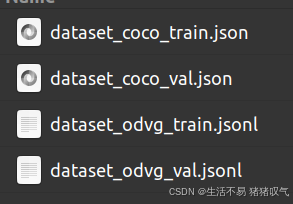教程参考:
https://blog.csdn.net/qq_44442727/article/details/137677031
GroundingDino是用提示词自动标注目标框的模型,如果想要训练自己的模型,就要使用Open-GroundingDino,项目地址:
https://github.com/longzw1997/Open-GroundingDino?tab=readme-ov-file
在此之前最好先跑通GroundingDino的项目,二者环境可以用同一个。我的环境配置在:
https://blog.youkuaiyun.com/zhaixiaobai/article/details/151796275?spm=1001.2014.3001.5502
1.测试环境
测试环境可不可以用,跑一下demo,注意下载好预训练模型。下载地址:https://github.com/IDEA-Research/GroundingDINO/releases(放在了weights目录下):
python tools/inference_on_a_image.py \
-c groundingdino/config/GroundingDINO_SwinT_OGC.py \
-p weights/groundingdino_swint_ogc.pth \
-i image_you_want_to_detect.jpg \
-o "dir you want to save the output" \
-t "chair"
-p是预训练模型路径、-i是待检测图像路径、-o为输出路径、-t是提示词。
能输出结果就是成功。
2.数据集制作
因为我有labelmg标注好的images和txt,所以这里我使用了脚本转换成coco和ODVG。
YOLO → COCO → ODVG(jsonl)
这样 Open-GroundingDINO 的 demo 与训练都可以直接读取。验证集的格式必须使用COCO格式,因为代码采用的是COCO数据集的计算方法,所以脚本中我们将txt转换成了两个文件:coco和ODVG。
import os
import json
import cv2
import argparse
import jsonlines
from tqdm import tqdm
from pycocotools.coco import COCO
# ----------------------------
# Step 1: YOLO → COCO
# ----------------------------
def yolo_to_coco(yolo_dir, img_dir, class_names, output_json):
images = []
annotations = []
ann_id = 1
img_id = 1
for filename in tqdm(os.listdir(img_dir), desc="Converting YOLO to COCO"):
if not filename.lower().endswith(('.jpg', '.jpeg', '.png')):
continue
img_path = os.path.join(img_dir, filename)
txt_path = os.path.join(yolo_dir, os.path.splitext(filename)[0] + ".txt")
if not os.path.exists(txt_path):
continue
img = cv2.imread(img_path)
h, w = img.shape[:2]
images.append({
"id": img_id,
"file_name": filename,
"height": h,
"width": w
})
with open(txt_path, "r") as f:
for line in f:
parts = line.strip().split()
if len(parts) != 5:
continue
cls, x_center, y_center, bw, bh = map(float, parts)
cls = int(cls)
x1 = (x_center - bw / 2) * w
y1 = (y_center - bh / 2) * h
bw_abs = bw * w
bh_abs = bh * h
annotations.append({
"id": ann_id,
"image_id": img_id,
"category_id": cls + 1, # COCO类别从1开始
"bbox": [x1, y1, bw_abs, bh_abs],
"area": bw_abs * bh_abs,
"iscrowd": 0
})
ann_id += 1
img_id += 1
categories = [{"id": i + 1, "name": name} for i, name in enumerate(class_names)]
coco_dict = {
"images": images,
"annotations": annotations,
"categories": categories
}
with open(output_json, "w") as f:
json.dump(coco_dict, f, indent=2)
print(f"✅ COCO annotations saved to {output_json}")
# ----------------------------
# Step 2: COCO → ODVG (加上 grounding 字段)
# ----------------------------
def coco_to_odvg(input_json, output_jsonl):
from pycocotools.coco import COCO
coco = COCO(input_json)
cats = coco.loadCats(coco.getCatIds())
nms = {cat['id']: cat['name'] for cat in cats}
metas = []
for img_id, img_info in tqdm(coco.imgs.items(), desc="Converting COCO to ODVG"):
ann_ids = coco.getAnnIds(imgIds=img_id)
instance_list = []
grounding_anns = []
categories_in_image = []
for ann_id in ann_ids:
ann = coco.anns[ann_id]
x, y, w, h = ann["bbox"]
bbox_xyxy = [round(x, 2), round(y, 2), round(x + w, 2), round(y + h, 2)]
label = ann["category_id"]
category = nms[label]
instance_list.append({
"bbox": bbox_xyxy,
"label": label - 1,
"category": category
})
grounding_anns.append({
"bbox": bbox_xyxy,
"label": label - 1,
"category": category,
"phrase": category # 用类别名作为短语
})
categories_in_image.append(category)
# 生成一句简单的 caption(例如 "crop1, weed")
caption = ", ".join(sorted(set(categories_in_image))) if categories_in_image else ""
metas.append({
"filename": img_info["file_name"],
"height": img_info["height"],
"width": img_info["width"],
"detection": {"instances": instance_list},
# === 新增 grounding 字段 ===
"grounding": {
"caption": caption,
"regions": grounding_anns
}
})
with jsonlines.open(output_jsonl, mode="w") as writer:
writer.write_all(metas)
print(f"✅ ODVG format (with grounding) saved to {output_jsonl}")
# ----------------------------
# Step 3: CLI入口
# ----------------------------
if __name__ == "__main__":
parser = argparse.ArgumentParser("Convert YOLO labels to ODVG format for Open-GroundingDINO.")
parser.add_argument("--img_dir", required=True, help="path to images folder")
parser.add_argument("--label_dir", required=True, help="path to YOLO txt labels")
parser.add_argument("--output_dir", required=True, help="output folder path")
args = parser.parse_args()
os.makedirs(args.output_dir, exist_ok=True)
coco_json = os.path.join(args.output_dir, "dataset_coco.json")
odvg_jsonl = os.path.join(args.output_dir, "dataset_odvg.jsonl")
# 标签(改成你自己的类别):
class_names = ["class1", "class2"]
yolo_to_coco(args.label_dir, args.img_dir, class_names, coco_json)
coco_to_odvg(coco_json, odvg_jsonl)
执行语句:
python yolo2odvg.py --img_dir /dataset/val/images --label_dir /dataset/labels --output_dir /dataset/output
其中yolo2odvg.py是脚本名称、–img_dir是图像文件夹路径、–label_dir是原来的txt格式的文件夹目录、output_dir是输出路径
得到的是coco格式的json与ODVG格式的jsonl(图中是自己改过名称,加了train和val后缀)

3.修改配置文件
3.1 config/cfg_odvg.py
修改:
use_coco_eval = False # 将True改为False
label_list=['dog', 'cat', 'person'] # 新增一个标签列表的字段,改为自己的label
3.2 config/datasets_mixed_odvg.json
这里是数据集的配置文件,其中train可以写多个(如下),如果只有一个训练集,就直接把第二个大括号删掉。
其中root为图像目录、train中的anno为coco格式的.json文件,val的anno为.jsonl文件、labelmap设为null、dataset_mode如图。
{
"train": [
{
"root": "/home/images",
"anno": "/home/Dataset/annotations/dataset_odvg_train.jsonl",
"label_map": null,
"dataset_mode": "odvg"
}
],
"val": [
{
"root": "/home/images",
"anno": "/home/Dataset/annotations/dataset_coco_val.json",
"label_map": null,
"dataset_mode": "coco"
}
]
}
4.训练
打开train_dist.sh文件,如果你是单卡,还需要修改最下方的一段,修改为:
python -m torch.distributed.launch --nproc_per_node=1 main.py \
--output_dir ./my_output \
-c config/cfg_odvg.py \
--datasets ./config/datasets_mixed_odvg.json \
--pretrain_model_path /path/to/groundingdino_swint_ogc.pth \
--options text_encoder_type=/path/to/bert-base-uncased
其中output_dir为输出目录、–datasets为刚才修改的数据集配置文件路径、–pretrain_model_path为权重文件路径、options是bert-base-uncased的路径,这里我没有按照最上面教程中的去配置,只写了一句:text_encoder_type = “bert-base-uncased”,AI说这样transformers 会自动下载对应的 tokenizer 与模型权重。
执行语句:
sh train_dist.sh
训练参数之类可以在cfg_odvg.py修改。




















 558
558










